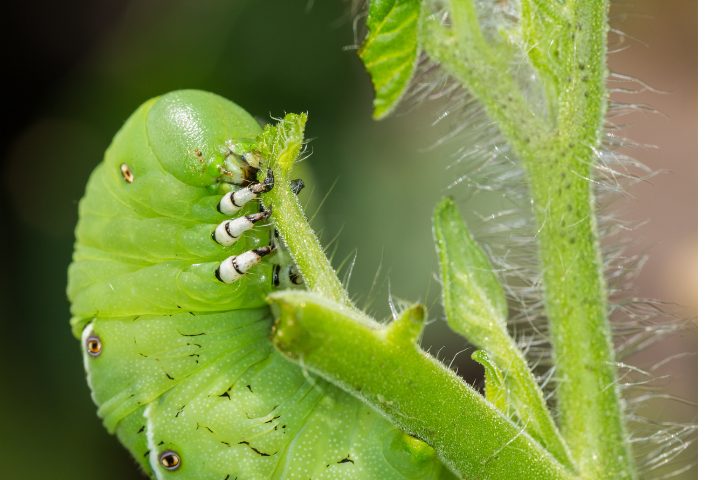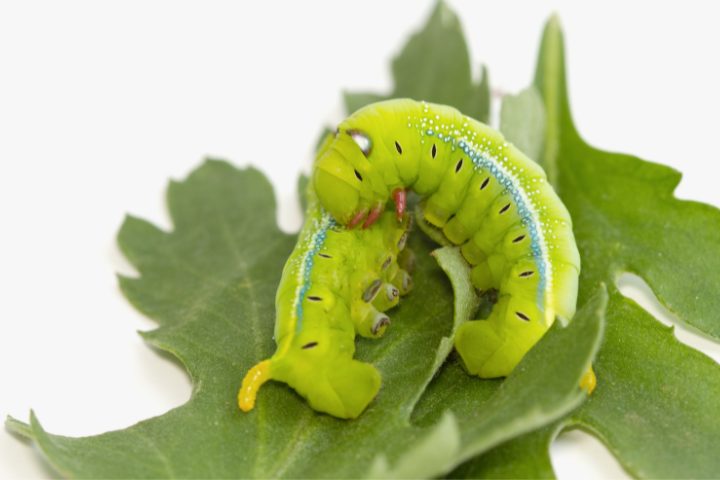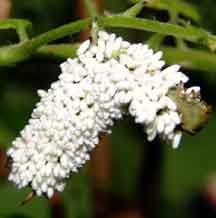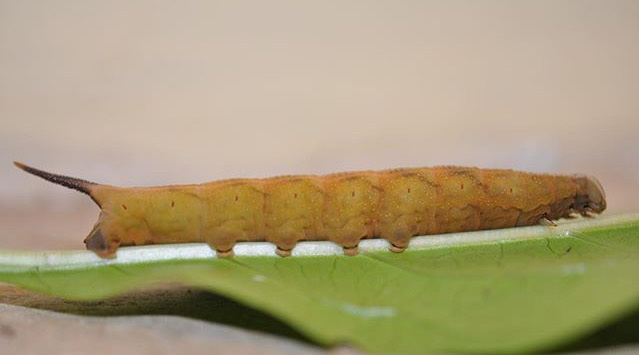Are you planning to raise hornworms in your home? Or worried about an infestation in your garden? Either way, questions like “what do hornworms eat” and how it affects us will be on top of your mind. Let’s answer them for you.
Planning to breed hornworms as feeder insects for your pet lizard? Well, then, you need to learn what to feed the hornworms to keep them healthy.
These insects can eat surprisingly large amounts of food every day, up to four times their weight. Thankfully, hornworms are fairly easy to feed as they’re herbivores and can survive on a variety of vegetables and other plant matter.

What Do Hornworms Eat in the Wild?
As hornworms have a diverse herbivorous diet, they can feed on various plant matter found in nature. These insects mostly eat the leaves of solanaceous plants and weeds. Green tomatoes and other vegetables are a part of their diet too.
Hornworms often flock to agricultural lands to feed on crops like eggplants, peppers, tobacco, potatoes, etc., which is why they’re categorized as pests.
You may also notice plenty of hornworms in regions with mulberry trees, as these insects love feeding on mulberry leaves.
What Do Different Types of Hornworms Eat?
There are primarily two types of hornworms commonly found and used as feeder insects – tomato hornworms and tobacco hornworms.
Their most common diets are evident from the name itself. The tomato hornworms prefer to feed on tomatoes and tomato plant leaves, while the tobacco hornworms love tobacco leaves.
However, in addition to tomato and tobacco plants, both types of hornworms also love other crops and plant matter mentioned earlier.

How Does the Hornworm Diet Impact Humans?
Unfortunately, much of the hornworm diet consists of crops and plants. Wild hornworms can cause extensive damage to agricultural farms and plantations.
Fruits and vegetables fed on by hornworms are no longer fit for human consumption, which means they go to waste.
While a small number of hornworms can’t do a lot of damage, infestations may call for pest control measures immediately.
Of course, the diet of hornworms you keep at home won’t impact you as you’re in control of what they eat. There’s no reason to worry as long as they don’t escape.
What To Feed Hornworms at Home?
Although hornworms have a huge appetite, you won’t have much trouble keeping them well-fed at home. You likely have some of the most common hornworm foods at home already.
You may regulate the quantity of food to control the growth rate of the hornworms as needed. Once they grow into adult moths, it might be hard for you to use them as feeder insects. Common foods that you can feed them at home include:
Hornworm chow
As the name suggests, hornworm chow is a pet food created specifically for hornworms. It is a mix of various ingredients, such as flake yeast, linseed oil, grapevine and dandelion leaves, agar, etc.
Hornworm chow has a longer shelf life than fresh foods, which makes them easy to stock up on.
Tomato plants
As mentioned earlier, hornworms love feeding on tomato plants. However, bear in mind that tomato leaves have toxins that your hornworms can retain.
If you’re planning to use your hornworms as feeder insects, don’t offer them tomato leaves, and never use wild hornworms to feed your pet.

Mulberry leaves or silkworm chow
You can feed your hornworms soft mulberry leaves, too. It’s one of the favorite foods for these insects. However, getting a regular supply of mulberry leaves can be difficult unless you have mulberry trees around your home.
As an alternative, you may use silkworm chow, another worm food which you can make using mulberry leaves.
Vegetables
You can even use vegetables as food for your hornworms. Don’t worry; you need not buy any special veggies for them.
Hornworms can eat various common vegetables that you might be buying regularly anyway. These include potatoes, celery, tomatoes, mustard greens, red bell peppers, collard greens, etc.
Tobacco
Tobacco leaves are a viable hornworm food, too, especially for tobacco hornworms. However, not all hornworms are capable of secreting the toxins they consume from tobacco. This can potentially turn them toxic and unsafe for your pet to eat.
Grapevine Leaves
Grapevines are a great source of fresh leaves for your hornworms. Not only are grapevine leaves easily available, but they’re also quite nutritious.
Grapevine leaves are perfect for feeding various other worms too. Eating grapevine leaves won’t make your hornworms turn toxic either, which makes them perfect for feeder hornworms.
Dandelion Leaves
Like grapevine leaves, dandelion leaves are a safe choice for those who want to feed their hornworms fresh leaves too.
Dandelion leaves are suitable for feeder worms, as they too are free of toxins. Just make sure not to feed your pets any dandelion leaves treated with weed killers or other toxic chemicals.
Water
You don’t have to provide water separately, as hornworms absorb the moisture they need from their food.
Besides the fact that they don’t even need to drink water, these worms can easily drown. If you still fear that your hornworms aren’t getting enough water, you may sprinkle some water on their food.
Diet Variations
Although hornworms are herbivorous, they might become cannibalistic or kill and eat other insects if they lack moisture and protein. To prevent such a mishap, make sure to provide them with a balanced diet.

Can Hornworms Eat Fruit?
Commercially cultured hornworms don’t usually feed on fruits, especially. However, wild hornworms might eat unripe fruits alongside the leaves of the plant.
Hornworm attacks on fruit plantations aren’t too uncommon either. But if you are planning to offer some fruit to pet hornworms, it is unlikely they will eat them.
However, hornworms don’t need fruits in their diet anyway. A proper combination of vegetables and leaves should provide them with all the nutrition they need.
Do Hornworms Need Water?
The fact that more than 80% of a hornworm’s body is water might make you think that they drink plenty of water. On the contrary, these insects rarely have to drink water.
The food eaten by hornworms usually gives their body all the water needed to function properly. Unlike most other animals and insects, hornworms don’t need any extra water in addition to their food.
You won’t have to make any special provisions to give water to your hornworms, which is excellent because hornworms are tiny insects that can easily drown.
How To Feed Your Hornworms?
To keep your hornworms healthy and growing, you’ll have to feed them properly. Assuming that you plan to use them as feeder insects for your pet, you’d also want to be careful about what you feed them.
As you might have noticed by now, some of the foods preferred by hornworms can turn them toxic. Eating such toxic insects can harm or even kill your pet.
Provide them with a balanced diet consisting of ample green veggies and leaves, besides hornworm or silkworm chow.

How To Cook Hornworm Food?
You’ll have to cook the hornworm chow before you can feed it to your hornworms. The commercially available hornworm chow usually comes in the form of a powder.
You need to boil four cups of water for every 0.5 lb of hornworm chow and add the powder to the water. Stir it until the mixture has blended well and there are no lumps.
You can now turn off the burner and let the mixture cool. However, keep stirring it so that it doesn’t form lumps.
Finally, pour out the mixture into a container and leave it there for an hour or two to solidify. Once the mixture has solidified, the hornworms can eat it.
How Much Do Hornworms Eat?
Despite their tiny size, hornworms have a huge appetite. However, the exact amount of food depends on how mature the hornworms are; and whether they’re going through a growth stage. A hornworm eats about 1 oz of hornworm chow while in the pupae stage.
How Often Should Hornworms Eat?
While hornworms are easy to feed, there’s a catch – you’ll have to provide them with fresh food every day, without fail.
Not getting food for even just a single day can kill them. You need to feed younger hornworms even more frequently, as their bodies require more water during the growth stage.
Wrapping up
Procuring food for hornworms isn’t too difficult. If you have a garden with a few nightshade family plants, it might be very easy for you.
However, keep in mind that it doesn’t take hornworms very long to grow from the larval stage to maturity before pupating and turning into moths. The female moths later lay hornworm eggs on plants, usually of the nightshade family.
The hawk moth (also called hummingbird moth) can act as pet food too. However, baby lizards might have trouble catching them to eat. Thank you for reading, and we hope this guide helps you raise your hornworms perfectly.
Reader Emails
Over the years, our readers have sent us several emails on this topic. Please go through them below.
Letter 1 – Tomato Hornworm from Canada
 Subject: Caterpillar
Subject: Caterpillar
Location: Coboconk Ontario Canada
September 20, 2013 5:04 pm
Found this our driveway today. Just wondering if u know what it is. We live in south central Ontario and tomorrow is the first day of fall. It is about 5 inches in length and diameter is about thumb size. Any info would be great!!!
Signature: Teacher
Dear Teacher,
We believe your Hornworm in the family Sphingidae might be that of a Pink Spotted Hawkmoth, Agrius cingulata. See Sphingidae of the Americas and BugGuide for photos of this highly variable caterpillar. We will try to confirm our identification with Bill Oehlke.
Bill Oehlke Responds
Manduca quinquemaculatus
Letter 2 – Hornworm from Costa Rica: Pachylia syces
 Subject: Butterfly Larve ??
Subject: Butterfly Larve ??
Location: Cartago, Costa Rica
February 17, 2016 11:01 am
Found a very big larve, I think is a butterfly, but can´t find the way to identify it. It is about 12cm long, I never seen before one this long. Thank you Mr. Bugman.
Signature: Juan Carlos Nuñez
Dear Juan Carlos,
This is not a butterfly larva. It is a Hornworm, the larva of a moth in the family Sphingidae. We believe it is Pachylia syces, the caterpillar of a large Sphinx Moth. You can find additional information on Sphingidae of the Americas where it states: “Larvae are reported to feed on Ficus microcarpa, Ficus prinoides, Ficus ovalis and Artocarpus integrifolia in Brazil. In the early instars, larvae greatly resemble Pseudosphinx tetrio or a coral snake. They thrash about when disturbed and also ‘squeak’.”
Letter 3 – Hornworm covered in Brachonid Pupa
 What is this bug?
What is this bug?
Hi,
My wife and I grow tomatoe plants every summer. Today we were looking for the last few remaining crop when she spotted this. We live in the Northeastern US (New York State, 45min north of Manhatten). Do you know what this is? It looks like a caterpillar.. Thanks,
Scott Shapiro

Hi Scott,
This is one of two species of Sphinx Moth in the genus Manduca that feed on tomato leaves and other related plants. They are commonly called Tomato Hornworms or Tomato Bugs. It has been parasitized by Brachonid Wasps and is covered with wasp pupa. We have never seen a caterpillar parasitized to this extent. Thanks for your image.
Letter 4 – Gardenia Bee Hawkmoth Caterpillar from Australia
 Subject: Ohhhh
Subject: Ohhhh
Geographic location of the bug: ORAN PARK nsw
Date: 03/03/2019
Time: 06:14 PM EDT
Your letter to the bugman: Hay bug man. I’m hoping you can tell me what sort of bug this guy or gal is. Found it out the back today and have never screen one before
How you want your letter signed: Curious mummy
Dear Curious Mummy,
This is a Hornworm, the larva of a Sphinx Moth or Hawkmoth in the family Sphingidae. We are confident it is the Gardenia Bee Hawkmoth Caterpillar which is pictured on Butterfly House and on FlickR. Do you have a gardenia growing near the sighting?
Letter 5 – Hornworm from Bali
 Subject: Unidentified sphinx moth caterpillar from Indonesia
Subject: Unidentified sphinx moth caterpillar from Indonesia
Location: Seminyak, Bali
March 15, 2017 3:01 pm
When I was visiting Bali, I found 3 of these caterpillars feeding on an unidentified bush. I took one of them with me to rear as I travelled. It grew very quick and turned a brown colour in its final instar. When I was in java the following week I found the same plant with the same caterpillars on it. I walked past the plant in the evening and saw a hummingbird like hawkmoth fluttering over the leaves depositing eggs. If you need more pictures I have documentation of every instar. Thankyou/ Joey
Signature: Joey Twomey
Dear Joey,
We haven’t the time to research your query this morning, but we are posting your image nonetheless. Perhaps Bostjan, who frequently identifies Hornworms for us, will recognize this individual. Knowing the plant upon which it was feeding would be a tremendous clue in ascertaining its identity. We would love to post a few more images.
The name of the food plant was Morinda citrifolia.
Joey Twomey
Letter 6 – Hornworm from Bolivia is Alope Sphinx
 Subject: possible snake caterpillar?
Subject: possible snake caterpillar?
Location: Yotau, Bolivia, South America
January 29, 2013 9:23 pm
My friend and I discovered this caterpillar on a papaya tree on a work break in July. I contacted National Geographic a few months ago to see if they could help me ID the bug, but I haven’t gotten a response yet, and I really want to know what this bug is. I would, however, like to keep the photo credits.
Can you help me ID this bug?
Signature: Kaylynn
Dear Kaylynn,
We are nearly certain this is a Hornworm, the caterpillar of a moth in the family Sphingidae, and one of your photos does show what appears to be a caudal horn, a trait common to most caterpillars in the family. There are several caterpillars in the family that mimic snakes, including this Hemeroplanes triptolemus which we posted back in 2005. We have gone a bit dizzy clicking through most of the possibilities on the Sphingidae of the Americas Bolivia page with no success. We have decided to contact Bill Oehlke to see if he can provide a species identification.
Update: Thanks to a comment from Ryan, we see that the Alope Sphinx, Erinnyis alope, is a close match. The photos on the Sphingidae of the Americas site were one of the few we did not check.
Letter 7 – Hornworm from Guatemala: Sphinx leucopheata:
 Subject: Identifying this grub or caterpillar
Subject: Identifying this grub or caterpillar
Geographic location of the bug: Lake Atitlan, Guatemala
Date: 06/16/2019
Time: 09:52 PM EDT
Your letter to the bugman: Hello,
Can you tell me what type of grub or caterpillar this is? It is bright green, red/ purple and white with a spiral
‘tail’. Around 3 inches long.
How you want your letter signed: Prema
Dear Prema,
This image is positively gorgeous. It is such a lovely study in subtle green colors and patterns. This is a Hornworm, the larva of a Hawk Moth or Sphinx Moth in the family Sphingidae, but we are not certain of the species. We are posting it as unidentified as we continue to research the species. Perhaps Bostjan will notice the posting and provide an identification.
Update: This looks to us like it might be Manduca hannibal hannibal, which is pictured on Sphingidae of the Americas. When Daniel returns to the office, he will contact Bill Oehlke for his opinion.
Thanks so much, Daniel!
I have it out there to a few naturalists here on Lake Atitlan.
I will let you know if I find out anything.
Best,
Prema
We would love to hear what you find out Prema. Do you by chance know the plant upon which it was feeding?
Good Morning Daniel,
I found it on the pathway near our house in Paxanax, Santa Cruz la Laguna, Lake Atitlan. Hence the one photo of it on the stone path and then the second one on the leaf. We moved it off the path unto the side where there were plants.
Thanks,
Hello Bostjan and Daniel,
Thanks so much for the information about this beautiful caterpillar! I will share it with my friends here at the Lake. I have to say that the photos have stirred up quite a fuss and people are anxious to know what species it is.
My friend and I found it on the pathway near our house in Paxanax, Santa Cruz la Laguna, Lake Atitlan. Hence the one photo of it on the stone path and then the second one on the leaf. We moved it off the path unto the side where there were plants away from any potential harm.
I will be in touch if I see this beauty again.
If you ever come to Lake Atitlan please contact me. We have many beautiful and amazing insects here 
Warm regards,
Prema
Update with Request: June 20, 2019
Hello again Prema. Dr. Bostjan Dvorak just submitted a sketch of this Hornworm species he made in 2016 and we have posted it. We have one additional request. Bill Oehlke maintains an excellent website called Sphingidae of the Americas and he frequently assists us with identifications. He has an image of an adult Sphinx leucopheata on Sphingidae of the Americas, but he has no images of the larvae. When Daniel returns to the WTB? office on Friday (he is currently on holiday in Ohio) he would like permission to submit your awesome images so he can provide his readership with documentation of the caterpillar.
Good Morning Daniel,
Absolutely! Big thanks to the team at WTB and your colleagues for all the work you do on the planet.
Have a great day!
The post What Do Hornworms Eat? #1 Answer appeared first on What's That Bug?.











No comments:
Post a Comment